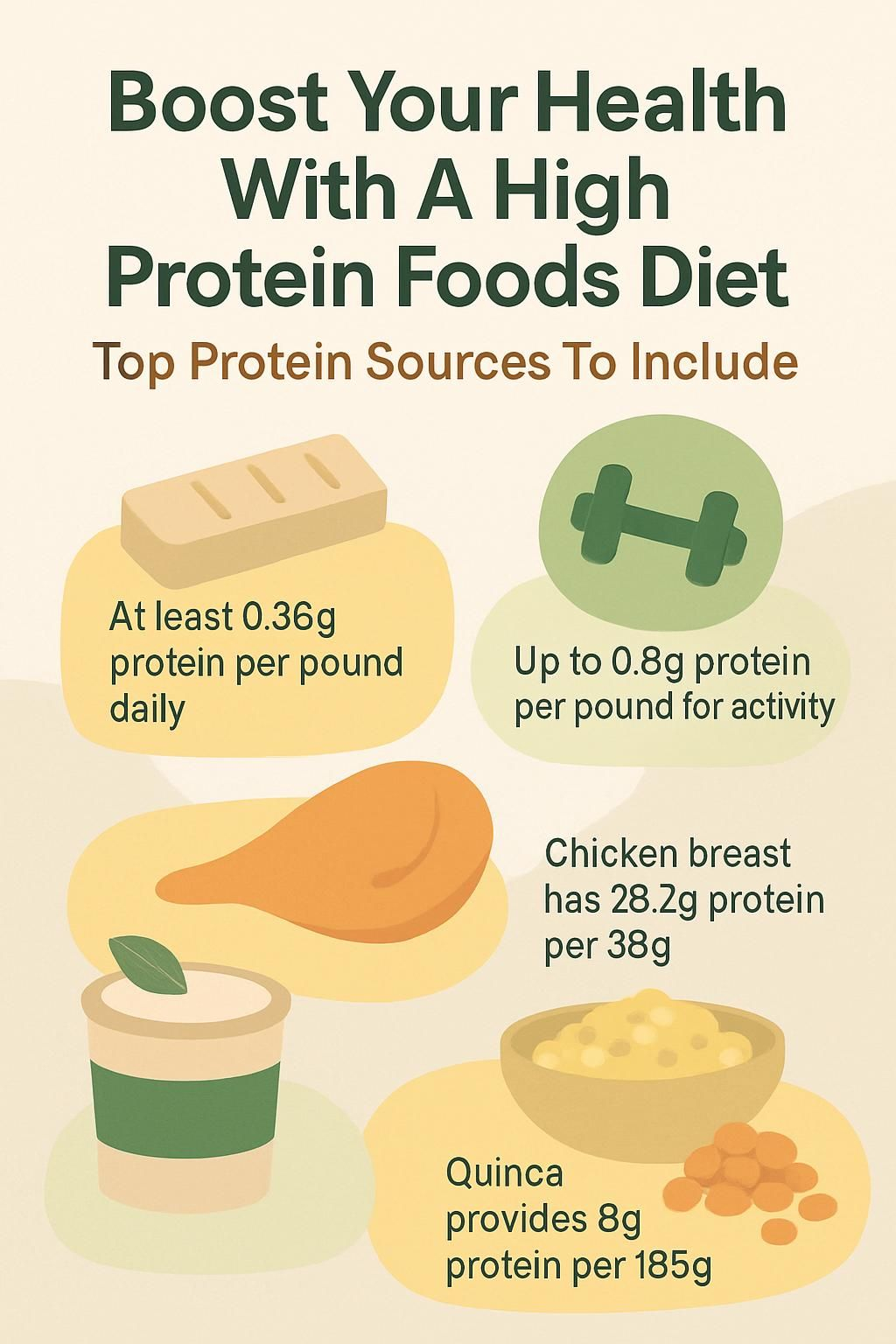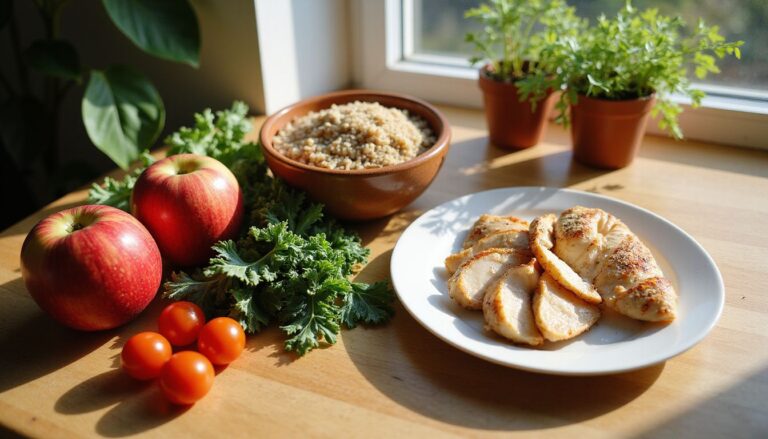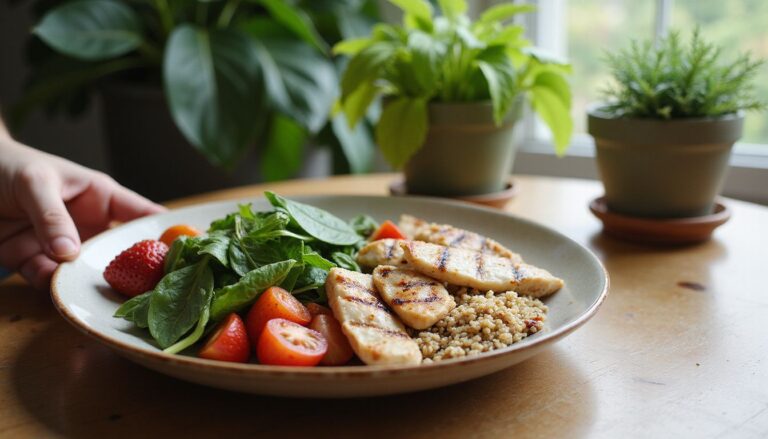Boost Your Health With A High Protein Foods Diet: Top Protein Sources To Include
Our Nutrition Assistant AI Suite will transform your body. You will lose fat, get toned, and build muscle. Gain confidence and optimal health.
You might feel tired, get stuck with weight loss, or want more muscle. Often the diet simply lacks enough protein. Protein builds muscle, supports the immune system, and repairs body tissues.
With a high-protein diet, you can choose foods that support weight management, steady energy, and health. This guide explains why protein matters, how much protein you need each day, and which high-protein foods belong on your plate.
Keep reading to see which protein sources can help you feel your best.
Key Takeaways
- Adults should get at least 0.36 grams of protein per pound each day. Active people may need 0.5 to 0.9 grams per pound for muscle growth.
- Eating more protein helps maintain muscle, raises calorie burn by about 15% to 30% during digestion, and increases fullness for weight control.
- Strong picks include chicken breast (26.7 g per 86 g), Greek yogurt (19.9 g per 200 g), eggs (6.3 g per 50 g), lentils (9.02 g per 100 g), quinoa (8 g per 185 g), and lean beef (24.6 g per 85 g).
- Mix animal and plant protein sources to cover all essential amino acids. Quinoa, soy foods, and Ezekiel bread can offer complete plant-based proteins.
- Plant proteins add fiber and less saturated fat. Replacing red meat with plant protein is linked with lower heart disease risk in large studies.

Why is Protein Important for Your Health?

Protein touches almost every system in your body. It is made of amino acids, the small building blocks that form tissues. Nine of these amino acids are “essential,” which means you must get them from food.
These building blocks support bones, cartilage, muscle mass, skin, blood cells, and enzymes. They also help make hormones that guide many body processes.
Getting enough dietary protein supports growth and repair at every age, especially in childhood and the teen years. Protein also helps with blood clotting, fluid balance, and immune defense.
Animal protein such as skinless chicken or lean beef supplies all essential amino acids, known as a complete protein. Many plant proteins become complete when you combine them across the day.
Research shows higher protein intake helps preserve muscle as you age, starting in your 30s. Keeping muscle supports mobility, balance, and a healthy metabolism.
“A high-protein diet can support your health by meeting vital tissue-building needs.”
Key Benefits of Eating a High-Protein Diet
A high-protein eating pattern can help you reach fitness and health goals sooner. Protein-rich foods often make meals more satisfying, which supports smart calorie control.
How Does Protein Support Muscle Growth and Maintenance?
Protein delivers amino acids that repair and build muscle fibers after exercise. Each workout creates tiny tears in muscle. Adequate protein helps those fibers recover and grow stronger.
Good sources include chicken breast, fish like salmon, eggs, and lentils. Aim for at least 0.36 grams per pound of body weight daily. Active people often need 0.5 to 0.9 grams per pound, or 1.2 to 2.0 grams per kilogram.
Adults over 50 may benefit from about 1.0 gram per kilogram per day to limit age-related muscle loss. A protein-rich snack after training, such as Greek yogurt or a shake, can speed recovery.
Going far above 2.0 grams per kilogram rarely helps unless you have extreme training needs. Balance protein with carbs and healthy fats for best results.
Can a High-Protein Diet Help With Weight Management?
Meals that are high in protein tend to increase fullness and reduce hunger later in the day. This can lower total calories without strict rules. Studies find that diets higher in protein often preserve muscle while body fat drops, especially when paired with exercise.
Try lean meats, Greek yogurt, eggs, beans, or quinoa. Many people report fewer late-night snacks once they add a protein source to each meal.
High-protein foods may help promote fullness after eating, making them useful tools for many diets for weight loss.
How Does Protein Boost Your Metabolism?
Protein has a higher thermic effect of food than carbs or fat. Your body uses more calories to digest it. Estimates show protein digestion can raise calorie burn by 15% to 30%, while carbs range from 5% to 10% and fat from 0% to 3%.
Choosing foods like chicken breast, Greek yogurt, or lean beef can nudge your daily energy burn higher. This may support weight goals and heart health when combined with an active lifestyle.
What Role Does Protein Play in Bone Health?
Protein provides structure for bone tissue. Pair it with calcium and vitamin D for stronger bones across the lifespan.
Dairy foods such as milk, yogurt, and cheese supply both complete protein and calcium. Studies link adequate dairy intake with better bone growth in children and a slower rate of bone loss in adults.
Plant choices like tofu and lentils also fit well. Diets that combine animal and plant proteins often show better bone mineral density than low-protein diets.
How Does Protein Enhance Recovery and Repair?
Protein supports repair after injury or intense training. Amino acids rebuild muscle, skin, and blood vessels that get stressed during activity.
Recovery needs are higher for a time. Many experts advise 1.2 to 2.0 grams per kilogram of body weight per day during healing or after surgery, as noted in United States Department of Agriculture resources. Including lean meats, eggs, Greek yogurt, or plant proteins helps the process.
How Much Protein Should You Eat Each Day?
The Recommended Dietary Allowance for adults is 0.36 grams per pound of body weight. For a 165-pound person, this equals about 60 grams per day. This amount supports basic repair and muscle health.
Active adults, athletes, or those using a high-protein diet for weight loss often need more. A range of 0.5 to 0.9 grams per pound, or about 1.2 grams per kilogram and higher, is common. Needs are also higher during pregnancy, breastfeeding, the teen years, and older adulthood.
To estimate your protein per day, multiply your weight in pounds by 0.36. Hitting your goal is easier when you spread protein across meals and snacks. Choose a mix of foods such as skinless chicken, Greek yogurt, seafood, legumes, nuts, and seeds.
Avoid going over 2.0 grams per kilogram of body weight on a regular basis. Very high-protein diets that crowd out carbohydrates or healthy fats can create nutrition gaps. If you have kidney disease or other medical concerns, seek guidance first.
Best High-Protein Foods to Add to Your Diet
Many foods are high in protein and bring useful nutrients for repair, bone strength, and weight management. Explore these options and rotate them through the week.
Are Eggs a Good Source of Protein?
Eggs are an excellent source of protein from animal foods. One large egg, about 50 grams, provides roughly 6.3 grams of complete protein. That means it contains all nine essential amino acids.
The whites carry most of the protein with few calories and little fat. Hard-boiled eggs make a fast breakfast or post-workout snack.
Eggs also offer vitamin B6, riboflavin, iron, vitamin E, folate, and other minerals. They fit vegetarian diets, but not a vegan diet.
How Do Almonds Contribute to Protein Intake?
Almonds add plant-based protein plus healthy fats and fiber. One ounce, about 28 grams, supplies 6 grams of protein. This beats many nuts, including cashews at 4.34 grams and pistachios at 5.73 grams per ounce.
Almonds also provide vitamin E, magnesium, and manganese. Use them as a snack, or toss them into oatmeal, salads, or yogurt to raise protein.
Why Choose Chicken Breast for Protein?
Half a chicken breast, about 86 grams, delivers 26.7 grams of high-quality protein. As a lean poultry choice, it has less saturated fat than many cuts of red meat or pork.
Chicken breast brings B vitamins, zinc, and selenium that support growth and tissue repair. Cook extra for quick salads, bowls, or sandwiches during the week.
What Makes Cottage Cheese a High-Protein Food?
One cup of cottage cheese, around 226 grams, provides about 28 grams of protein. It is lower in calories than many cheeses and supports muscle growth and weight goals.
It also supplies calcium and vitamin B12 for bone and nerve health. Compared with cheddar or mozzarella, cottage cheese gives more protein per calorie.
Enjoy it plain, with fruit, or mixed into salads and grain bowls. Many athletes keep it on hand for an easy protein boost.
How Much Protein Does Greek Yogurt Provide?
Strained Greek yogurt packs about 19.9 grams of protein in a 7-ounce, or 200-gram, serving. That is almost double the protein in the same amount of regular low-fat yogurt.
Stir it into breakfast bowls, smoothies, or savory dips. The creamy texture adds satisfaction while supporting muscle recovery and bone health.
Is Milk a Good Protein Source?
One cup of milk, 246 milliliters, has about 8.32 grams of protein. Milk also delivers calcium for bones and iodine for thyroid health.
If lactose causes symptoms, choose lactose-free milk or try other protein foods. Many people use milk after workouts to support recovery with both carbs and protein.
Can Lentils Help Meet Your Protein Needs?
Cooked lentils provide 9.02 grams of protein per 100 grams. That is more than chickpeas at 7.05 grams and similar to black beans at 8.86 grams.
Lentils are budget friendly, rich in fiber, and support heart health. A pot of lentil soup or a lentil salad bowl can keep you full for hours.
Why Include Lean Beef in a High-Protein Diet?
Three ounces of lean beef, about 85 grams, deliver 24.6 grams of protein plus heme iron, zinc, selenium, and B vitamins. Iron from beef absorbs well and helps prevent anemia.
Choose lean cuts and enjoy in moderation since frequent intake of red meat is linked with a higher risk of colorectal cancer. Pair beef with vegetables and whole grains for a balanced meal.
Which Fish Are High in Protein (e.g., Salmon, Tuna)?
Fish offers high-quality protein and key nutrients. Half a salmon fillet, about 124 grams, supplies 30.5 grams of protein. Tuna is another top choice. A cod fillet can reach about 41 grams of protein per 180-gram serving.
Fish provides iodine, selenium, and vitamin B12. Fatty fish like salmon and herring are rich in omega-3 fatty acids that support heart health. Add fish to salads or wraps for quick, protein-rich meals.
Is Quinoa a Complete Protein Source?
Quinoa stands out among grains. One cup cooked, 185 grams, delivers 8 grams of protein and all nine essential amino acids, so it is considered a complete protein.
Some amino acids, such as lysine, are present in lower amounts than in animal protein, but quinoa still supports a plant-forward plate. It also brings fiber, folate, iron, copper, and zinc.
How Can Protein Powders Supplement Your Diet?
Protein powders can help when whole foods are not convenient. A typical scoop of whey protein powder provides around 16.6 grams of high-quality protein in 28.6 grams of powder. Pea protein often gives about 15 grams per 20-gram scoop.
Blend into shakes after workouts or use in smoothies when appetite is low. If you have kidney disease or other conditions, talk with your healthcare provider before adding supplements.
What Are the Protein Benefits of Ezekiel Bread?
Ezekiel bread is made from sprouted grains and legumes like wheat, barley, soybeans, lentils, spelt, and millet. One 50-gram slice provides about 6 grams of protein and more fiber than white bread.
Sprouting can improve nutrient availability. Use this bread for toast or sandwiches to raise both protein and fiber in meals.
Are Pumpkin Seeds a Good Protein Snack?
Pumpkin seeds are a crunchy, high-protein snack. A quarter cup, about 29.5 grams, delivers 8.8 grams of protein, plus magnesium, zinc, and iron.
Sprinkle them on Greek yogurt, salads, or oatmeal. Pre-portion small bags to keep handy, which can reduce less healthy snacking.
Why Eat Turkey Breast for Protein?
Turkey breast is a lean protein that supports muscle repair. A 3-ounce serving, about 85 grams, provides roughly 25.6 grams of protein with few calories and little saturated fat.
It also supplies selenium, zinc, and B vitamins. Many athletes choose turkey after training to support recovery without excess fat and calories.
How Does Shellfish Provide Protein?
Shellfish offer protein with few calories. Three ounces, or 85 grams, of cooked clams contain about 21.8 grams of protein. Shrimp provide around 20.4 grams per serving of the same size.
They also bring minerals and omega-3s that support cell growth and immune function. Clams, mussels, and shrimp make quick, nutrient-dense meals.
Can Peanuts and Peanut Butter Boost Protein Intake?
Peanuts and peanut butter are simple ways to add plant protein. One ounce of peanuts contains about 7.31 grams of protein. Two tablespoons of peanut butter provide about 7.2 grams.
They also include folate, magnesium, and vitamin E. Spread peanut butter on whole-grain toast or pair it with apple slices for a balanced snack.
Comparing Animal-Based and Plant-Based Protein Sources
Animal and plant proteins both have a place in a healthy eating pattern. The chart below highlights key differences and how to use each wisely.
| Aspect | Animal-Based Protein Sources | Plant-Based Protein Sources |
|---|---|---|
| Examples | Chicken breast, eggs, milk, lean beef, Greek yogurt, turkey, fish, shellfish, cottage cheese | Almonds, lentils, quinoa, pumpkin seeds, peanuts, peanut butter, Ezekiel bread |
| Nutritional Completeness | Complete proteins. Contain all nine essential amino acids. Support muscle repair and growth effectively. | Most are incomplete proteins; often lack one or more essential amino acids. Quinoa and soy are exceptions, offering complete amino acid profiles. Combine various plant proteins for full amino acid coverage. |
| Protein Quality (PDCAAS Score*) | High scores: Eggs (1.00), milk (1.00), chicken breast (1.00), whey (1.00) Support high digestibility and absorption. | Moderate scores: Lentils (0.52), almonds (0.40), peanuts (0.52), quinoa (0.78) Combine foods like beans and rice to improve quality. |
| Fat Content | Can be high in saturated fat, especially in red meat and full-fat dairy. Choose lean cuts and low-fat dairy to reduce saturated fat intake. | Low in saturated fat; often contain heart-healthy unsaturated fats. Support cholesterol management and cardiovascular health. |
| Other Nutrients | Rich in vitamin B12, heme iron, zinc, calcium (dairy), and omega-3s (fish). | Provide fiber, antioxidants, vitamins, minerals, and phytonutrients. Lack vitamin B12 and heme iron unless fortified. |
| Health Risks | Red/processed meats linked to higher cardiovascular disease and diabetes risk. High sodium in processed meats. Meta-analysis (2022) shows replacing red meat with plant protein lowers cardiovascular risk. | Associated with lower cardiovascular disease risk. High intake of legumes, nuts, and whole grains supports weight management and glycemic control. |
| Dietary Patterns | Mediterranean diet and DASH diet emphasize lean meats and fish. Avoid excessive red/processed meat. | Mediterranean diet prioritizes legumes, nuts, seeds, and whole grains. Plant-forward eating patterns encouraged. |
| Environmental Impact | Higher greenhouse gas emissions. Greater land and water use. | Lower environmental footprint. More sustainable for long-term food security. |
*PDCAAS: Protein Digestibility Corrected Amino Acid Score
Include both animal and plant proteins to get complete amino acids, fiber, and a wide mix of vitamins and minerals. Rotate choices across the week for balance and variety.
How Can You Add More Protein to Your Diet?
Small steps add up. These tips make a higher protein intake simple to maintain.
Why Add Protein to Every Meal?
Including high-quality protein at breakfast, lunch, and dinner helps you reach your target, often 100 to 150 grams for many active adults. Spreading protein out improves absorption and keeps muscles fueled.
Practical ideas include eggs or strained yogurt at breakfast, skinless chicken or tofu at lunch, and fish or beans at dinner. Choose fava beans, tree nuts, and seeds to raise both protein and fiber.
When Should You Use Protein Powders or Shakes?
Busy schedules or higher needs can make whole-food protein hard to hit. A scoop of protein powder often provides 15 to 17 grams and works well in shakes or smoothies.
Use shakes after workouts, during illness recovery, or when appetite is low. Older adults and athletes often find them helpful for maintaining muscle.
How to Combine Plant Proteins for Complete Amino Acids
Mix different plant proteins to cover all essentials. Pair beans or lentils with grains such as rice, quinoa, or whole-wheat bread.
Examples include black beans with brown rice, hummus with whole-grain pita, or tofu with quinoa. Nut butters on whole-grain toast and salads topped with seeds and chickpeas also work well.
What Are Good High-Protein Snack Options?
Greek yogurt has about 19.9 grams of protein per 7-ounce serving and keeps you full. Pumpkin seeds add 8.8 grams per quarter cup along with minerals for bone and cell health.
Peanut butter gives around 7.2 grams per two tablespoons. Spread it on whole-grain bread or use it with apple slices for extra fiber and vitamins. Unsweetened trail mix delivers protein plus healthy fats for steady energy.
What Precautions Should You Take With a High-Protein Diet?
A high-protein pattern can affect fluid needs and kidney workload. If you have medical conditions or plan large changes, get personalized advice first.
Why Balance Protein With Other Nutrients?
Protein-rich foods also deliver fats, carbohydrates, vitamins, and minerals. Your body needs all of these for normal cell and tissue function.
Focusing too much on protein can crowd out fiber and certain micronutrients. This may cause constipation, low energy, or other issues over time. Balancing your plate with vegetables, fruits, whole grains, and healthy fats helps prevent gaps.
What Are the Risks of Excessive Protein Intake?
Regularly eating over 2.0 grams of protein per kilogram of body weight, for example above 125 grams for a 140-pound person, can strain the kidneys. It also raises the risk of kidney stones.
High protein increases fluid needs. Without enough water, dehydration can develop. Diets centered on animal protein may bring more saturated fat, which can increase cardiovascular risk.
Other possible effects include bad breath, constipation, and unintended weight gain if fiber and activity are low. Pay attention to how you feel and adjust as needed.
When to Consult a Healthcare Provider About Protein?
If you have kidney disease, diabetes, or heart disease, speak with a clinician or a registered dietitian before increasing protein. They can set a safe target based on your age, weight, activity, and labs.
Periodic check-ins can confirm that your plan supports health without added risk.
Sample High-Protein Meal Plan Ideas
Use these simple ideas to build days that hit your protein goals and still taste great.
What Is a Healthy High-Protein Breakfast?
Scrambled eggs supply about 6.3 grams of protein per egg. Add spinach and whole-wheat toast for fiber and steady energy.
Greek yogurt is another strong choice, with 19.9 grams per 7 ounces. Both options help manage hunger and support muscle repair after morning activity.
What Makes a Balanced High-Protein Lunch?
A chicken salad sandwich on whole-wheat bread provides roughly 25 grams of protein from 3 ounces of chicken plus about 4 grams of fiber from the bread. Add leafy greens and tomatoes for vitamins and minerals.
Round out the meal with Greek yogurt or a handful of almonds to boost protein and healthy fats.
How to Prepare a High-Protein Dinner
Grill a salmon fillet around 124 grams for about 30.5 grams of high-quality protein. Roast broccoli or bell peppers for fiber and vitamins.
Cook one cup of quinoa for about 8 grams of additional protein. Rotate proteins through the week, such as fish, skinless chicken, tofu, or lentils. If you choose fish often, vary species to limit methylmercury exposure.
What Are Easy High-Protein Snack Choices?
Keep Greek yogurt, pumpkin seeds, and peanut butter on hand. For example, yogurt with seeds gives nearly 29 grams of protein in minutes.
Trail mix made from nuts and seeds travels well and supports steady energy between meals.
Conclusion
A high-protein foods diet can help you feel satisfied, maintain muscle, and support heart health. Build meals from a mix of protein sources, such as eggs, chicken breast, lentils, quinoa, fish, and nuts.
Meeting your daily protein target becomes easier when you include a source of protein at each meal and snack. If you have a medical condition or plan big changes, speak with a healthcare professional first.
Smart choices today can strengthen your body, protect your bones, and support steady progress toward your goals.
Evidence sources: National Institutes of Health, United States Department of Agriculture, Academy of Nutrition and Dietetics, and recent meta-analyses on dietary protein and cardiometabolic risk.
FAQs
1. What are the best protein sources to support overall health?
Lean meats such as chicken and turkey, fish like salmon and tuna, eggs, dairy products including Greek yogurt and cottage cheese, legumes such as lentils and chickpeas, tofu, nuts, and seeds all provide high-quality protein that supports overall health.
2. How does a high protein foods diet benefit overall health?
A diet rich in protein helps build muscle mass, repair body tissues, maintain healthy bones, regulate hormones, and promote satiety. Studies show that higher protein intake can help with weight management while supporting metabolic function for better overall health (Phillips et al., 2016).
3. Can plant-based foods offer enough protein for good health?
Yes; beans like black beans or kidney beans along with peas contain significant amounts of plant-based protein. When combined with whole grains or seeds throughout the day these foods supply essential amino acids needed for optimal overall health.
4. How much daily protein do adults need to boost their overall health?
Most adults should aim for at least 0.8 grams of dietary protein per kilogram of body weight each day according to current guidelines from credible nutrition organizations (Institute of Medicine). For example if you weigh 150 pounds you would need about 55 grams daily to support your body’s needs and improve your overall health.
Personal Experience: After increasing my intake of lean poultry fish eggs legumes and low-fat dairy I noticed improved energy levels during exercise routines which made it easier to stay active every week.
Summary: High-protein diets using diverse sources such as animal products legumes nuts seeds or dairy can enhance muscle strength tissue repair hormone balance bone density appetite control metabolic rate and general well-being when tailored appropriately for individual needs based on scientific evidence.







